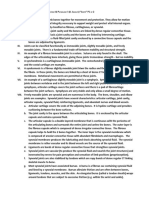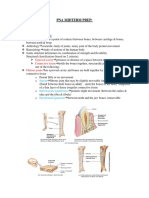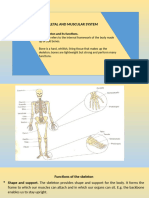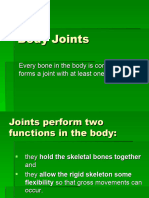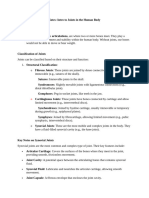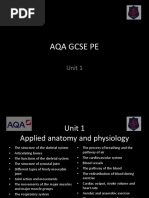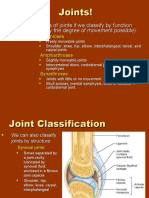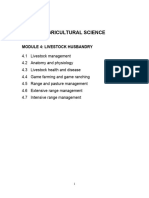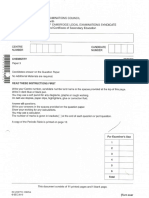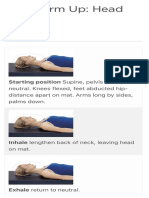Support and Locomotion
Support and Locomotion
Uploaded by
diegocmakoCopyright:
Available Formats
Support and Locomotion
Support and Locomotion
Uploaded by
diegocmakoCopyright
Available Formats
Share this document
Did you find this document useful?
Is this content inappropriate?
Copyright:
Available Formats
Support and Locomotion
Support and Locomotion
Uploaded by
diegocmakoCopyright:
Available Formats
SUPPORT AND LOCOMOTION
This is a combination of tough structures or fluids responsible for provision of support and movement in
organisms.
Actions of Skeletal muscles
Moving the lower arm involves the movement around a joint, the elbow and this is achieved by
the action of an antagonistic pair of muscles which are the biceps and the triceps.
Bending a hinge joint is called flexion and straightening it is called extension. The muscles that
cause flexion are known as flexor and that causes extension is called extensor. At the elbow, the
biceps muscle is the flexor while the triceps is the extensor.
When the muscles return to their original length, they relax.
The upper muscles contain a single bone, called the humerus. The bone fits into the spherical
socket in the shoulder bone or scapula. At the elbow, the humerus joins the ulna (which is the
first lower arm bone) and the radius (which is the second lower arm bone).
The biceps muscle is joined to the scapula and humerus at one end, and to the ulna at the other.
The triceps muscle is joined to the scapula at one end and to the ulna at the other. The ‘Bi’ and
‘Tri’ are the names given to the number of places at which each of the muscles is joined at the
upper end. The biceps is joined in two places and the triceps in three.
Each muscle is joined to the bones by a bundle of strong, non-stretching fibres called a tendon.
The two sets of muscles do not contract together when the biceps contract, the triceps relax to
ensure movement.
Types of joints
Type Example Explanation
Slightly movable joints Bones are supported by a layer of
a. Gliding joints Wrist and ankle joints cartilage and only slightly restricted
b. Rotating joints Joints just below the skull movement are permitted. Such joints are
capable of sustaining heavy loads.
Movable (synovial joints) Each bone is covered by a cartilage and
a. Hinge joints Elbow and knee the 2 bones are separate forming a
synovial fluid.
b. Ball and socket Between the arms and shoulder Ball and socket joints are where rounded
joints Between the thigh and pelvis heads of one bone fits into a socket or
cavity of another bone. Allowing
movements in all planes (directions).
1|Page
You might also like
- Hatch Squat ProgramDocument7 pagesHatch Squat ProgramRico martin OsoNo ratings yet
- USMC Daily 16 Workout ManualDocument20 pagesUSMC Daily 16 Workout Manualth1sisnotmyusername100% (3)
- Jim Wendler's 5/3/1: Wendler 5-3-1, 1 Day Per WeekDocument11 pagesJim Wendler's 5/3/1: Wendler 5-3-1, 1 Day Per WeekMatthew PurdyNo ratings yet
- Skeleton - Movement and LocomotionDocument80 pagesSkeleton - Movement and Locomotionpreethi bharathNo ratings yet
- Chapter 1Document67 pagesChapter 1adaveq3No ratings yet
- JointsDocument5 pagesJointsSEAN JODI M. COSEPENo ratings yet
- 13-Support and Movement ArisDocument48 pages13-Support and Movement Arisb2ppqsr6qxNo ratings yet
- JOINTSDocument14 pagesJOINTSyohanap741No ratings yet
- Muscle Skeletal MuscleDocument5 pagesMuscle Skeletal MuscleNatukunda DianahNo ratings yet
- JointsDocument27 pagesJointsVarsha Mol MohananNo ratings yet
- Joints (Summary)Document5 pagesJoints (Summary)TheLegendKiller337No ratings yet
- SkeletonDocument5 pagesSkeletonlolohmathersNo ratings yet
- Joints NotesDocument2 pagesJoints NotesDeva ChiruNo ratings yet
- Classification of JointsDocument10 pagesClassification of JointsegentialexaNo ratings yet
- Joints & Their Movements001Document14 pagesJoints & Their Movements001welcome homeNo ratings yet
- Articulation SDocument4 pagesArticulation SJohn Benedict VocalesNo ratings yet
- 02 Handout 2 (4) 2Document5 pages02 Handout 2 (4) 2Senpai LeonNo ratings yet
- Anatomy and Human Movement Lec5 DrDocument10 pagesAnatomy and Human Movement Lec5 DrisraaalhawaniNo ratings yet
- Arthrology: DR N. ChikumbaDocument50 pagesArthrology: DR N. ChikumbaNatty ChikumbaNo ratings yet
- Grade-7 Joints and Muscles NotesDocument3 pagesGrade-7 Joints and Muscles NotesSahithi P100% (4)
- SEDS11 Bones Worksheet AnswersDocument13 pagesSEDS11 Bones Worksheet Answersjeffersonmanalo787No ratings yet
- Bones and JointsDocument15 pagesBones and JointsRegina AlcaideNo ratings yet
- Chapter 8 MariebDocument5 pagesChapter 8 MariebmjhenkeNo ratings yet
- Nikkupdfonjoints 180220063659Document84 pagesNikkupdfonjoints 180220063659Adu-danquah StephenNo ratings yet
- kinesiology( movement of joints)Document7 pageskinesiology( movement of joints)ousoshine123No ratings yet
- Revision 1Document18 pagesRevision 1John MwengweNo ratings yet
- Pna Midterm Prep: Joints Classification of Joints:: Synovial Cavity Connective Tissue Fibrous JointsDocument4 pagesPna Midterm Prep: Joints Classification of Joints:: Synovial Cavity Connective Tissue Fibrous JointsaamenaNo ratings yet
- Classification of Joints-Dr - GosaiDocument10 pagesClassification of Joints-Dr - GosaiDr.B.B.GosaiNo ratings yet
- Anatomy of JointsDocument5 pagesAnatomy of JointsJayson CastroNo ratings yet
- Chapter 3 THE BONES AND MUSCLES A1 and A2Document15 pagesChapter 3 THE BONES AND MUSCLES A1 and A2Marinette Valencia MedranoNo ratings yet
- Biology Form 5 Chapter 2:locomotion and Support: To: Mrs AnnamalDocument25 pagesBiology Form 5 Chapter 2:locomotion and Support: To: Mrs AnnamalAnnamal ArulnathanNo ratings yet
- The Human Skeleton and Its Functions-1Document15 pagesThe Human Skeleton and Its Functions-1sofoniass70No ratings yet
- G11 - Bio - Pract - Study of Different Types of JointsDocument5 pagesG11 - Bio - Pract - Study of Different Types of Jointsbelamondal713No ratings yet
- Joints & MusclesDocument14 pagesJoints & Musclesp605993No ratings yet
- Body JointsDocument28 pagesBody JointsAlban Presley R. SangmaNo ratings yet
- 10 JointsDocument6 pages10 Jointsapi-159564163No ratings yet
- JointsDocument11 pagesJointsCelina NassarNo ratings yet
- Classificationofjoints 140413054157 Phpapp01 161023170805Document49 pagesClassificationofjoints 140413054157 Phpapp01 161023170805Adu-danquah StephenNo ratings yet
- 4 JointsDocument47 pages4 JointsFareez HamidNo ratings yet
- Principals of Anatomy Energy Systems IncDocument224 pagesPrincipals of Anatomy Energy Systems Inckevinramirezzz365No ratings yet
- Anaphy Lab Skeletal Chap1Document7 pagesAnaphy Lab Skeletal Chap1mashlenagatoroNo ratings yet
- Anatomy Sendi WebDocument10 pagesAnatomy Sendi WebazimahakimNo ratings yet
- Sama Notes Upper LimbDocument15 pagesSama Notes Upper LimbMaiUyen Kieu50% (2)
- Joints 9.9.2021Document16 pagesJoints 9.9.202121120072No ratings yet
- Notes - Intro To JointsDocument3 pagesNotes - Intro To JointsbeanNo ratings yet
- Anatomy, Joints - StatPearls - NCBI BookshelfDocument9 pagesAnatomy, Joints - StatPearls - NCBI BookshelfDave FisherNo ratings yet
- Joint: It Is The Site Where Two or More Bones Come Together, Where There Is Movement or NotDocument20 pagesJoint: It Is The Site Where Two or More Bones Come Together, Where There Is Movement or Notrabia ToorNo ratings yet
- Unit 1 Presentation WeeblyDocument85 pagesUnit 1 Presentation Weeblyapi-276945651No ratings yet
- Hip Joint - Anatomy and Physiology: LigamentsDocument3 pagesHip Joint - Anatomy and Physiology: LigamentsNeil AlviarNo ratings yet
- 11.2a MovementDocument33 pages11.2a Movementambercui1113No ratings yet
- Module-3-PE-1 PlainDocument15 pagesModule-3-PE-1 PlainClarrene LappayNo ratings yet
- HumanDocument3 pagesHumanJonnah Lamson-VillaricoNo ratings yet
- The Skeletal SystemDocument11 pagesThe Skeletal SystemAbhi LiteNo ratings yet
- Selfstudys Com FileDocument4 pagesSelfstudys Com FileAyaan ShaikhNo ratings yet
- Document 5Document22 pagesDocument 5dawidkubiak222No ratings yet
- 11.2 Movement: 11.2 Movement AHL Animal PhysiologyDocument14 pages11.2 Movement: 11.2 Movement AHL Animal PhysiologyReshma DookarranNo ratings yet
- JointsDocument20 pagesJointscumlittleeNo ratings yet
- Core 2 Body in Motion 65026f0d1277cDocument61 pagesCore 2 Body in Motion 65026f0d1277careebah.shahbaz1No ratings yet
- JointsDocument22 pagesJointswazzupwaleedNo ratings yet
- Sport Science NotesDocument5 pagesSport Science NotesSpicyChildrenNo ratings yet
- Articular System 2 Transcript - 5Document4 pagesArticular System 2 Transcript - 5estellasr00No ratings yet
- Introduction To BiomechanicsDocument38 pagesIntroduction To BiomechanicshjnnbNo ratings yet
- Improving Ankle and Knee Joint Stability: Proprioceptive Balancefit Discs DrillsFrom EverandImproving Ankle and Knee Joint Stability: Proprioceptive Balancefit Discs DrillsNo ratings yet
- Module 4Document80 pagesModule 4diegocmakoNo ratings yet
- Module 2 1Document97 pagesModule 2 1diegocmakoNo ratings yet
- Transport in PlantsDocument4 pagesTransport in PlantsdiegocmakoNo ratings yet
- Answering Paper 1 ItemsDocument22 pagesAnswering Paper 1 ItemsdiegocmakoNo ratings yet
- Answering Paper 1 Questions Effectively - GSS 2022Document12 pagesAnswering Paper 1 Questions Effectively - GSS 2022diegocmakoNo ratings yet
- Module 5Document18 pagesModule 5diegocmakoNo ratings yet
- Module 4.2 - Livestock Husbandry-2Document101 pagesModule 4.2 - Livestock Husbandry-2diegocmakoNo ratings yet
- 2011 Chemp 1Document14 pages2011 Chemp 1diegocmakoNo ratings yet
- Module 3Document23 pagesModule 3diegocmakoNo ratings yet
- Module 4.2 - Digestion in Ruminants & Non-RuminantsDocument86 pagesModule 4.2 - Digestion in Ruminants & Non-RuminantsdiegocmakoNo ratings yet
- 2.1 Thermal Physics 1Document12 pages2.1 Thermal Physics 1diegocmakoNo ratings yet
- Bgcse Physics Paper 3 2011Document15 pagesBgcse Physics Paper 3 2011diegocmako100% (2)
- 2.2 Thermal Physics 2Document10 pages2.2 Thermal Physics 2diegocmakoNo ratings yet
- Null 12Document13 pagesNull 12diegocmakoNo ratings yet
- 2009 Chemp 3Document11 pages2009 Chemp 3diegocmakoNo ratings yet
- 2008 Chemp 3Document12 pages2008 Chemp 3diegocmakoNo ratings yet
- Physics 2016 1 2 3 CompressedDocument53 pagesPhysics 2016 1 2 3 CompresseddiegocmakoNo ratings yet
- Chemistry Paper 1Document108 pagesChemistry Paper 1diegocmakoNo ratings yet
- 2010 Chemp 3Document12 pages2010 Chemp 3diegocmakoNo ratings yet
- 2012 Chemp 3Document11 pages2012 Chemp 3diegocmakoNo ratings yet
- 2016 Chemp 3Document11 pages2016 Chemp 3diegocmakoNo ratings yet
- 2011 Chemp 3Document14 pages2011 Chemp 3diegocmakoNo ratings yet
- PE 3 Group Output 3rd QRTRDocument2 pagesPE 3 Group Output 3rd QRTRJoan Arafiles BiggayanNo ratings yet
- ExercisesDocument115 pagesExercisesAdriana CordobaNo ratings yet
- Junior Analytical Grammar 0910Document2 pagesJunior Analytical Grammar 0910Kash R100% (2)
- Speaking part 2Document5 pagesSpeaking part 2nguyenthikimngan27052003No ratings yet
- Yoga in BengalDocument26 pagesYoga in BengalscribewalaNo ratings yet
- Trabajo de Ingles Ivan Martinez 2558005Document7 pagesTrabajo de Ingles Ivan Martinez 2558005Santiago martinezNo ratings yet
- Pe Quarter 4 - Week 4Document36 pagesPe Quarter 4 - Week 4Mherasul PasayloNo ratings yet
- Shoulder Function, Exercise Modifications, Strategies For Trainers (NSCA 2005)Document10 pagesShoulder Function, Exercise Modifications, Strategies For Trainers (NSCA 2005)Fitness Tutor for the ACE & NSCA Exams100% (1)
- Fitness and WellnessDocument9 pagesFitness and WellnessJulhayda FernandoNo ratings yet
- 2022 Article 547Document12 pages2022 Article 547NataliaArtigasNo ratings yet
- How To Drop Anchor in Bed - ACT Made Simple - Extra Bits - Chapter 10Document3 pagesHow To Drop Anchor in Bed - ACT Made Simple - Extra Bits - Chapter 10psiho2024No ratings yet
- Teks Healthy Mind and BodyDocument2 pagesTeks Healthy Mind and BodyDimas Galih KiranaNo ratings yet
- Connectors in English GrammarDocument11 pagesConnectors in English GrammarIoanna Thayren95% (82)
- Syuhadah Work OutDocument15 pagesSyuhadah Work OutNoor Aimah Binti NulhasanNo ratings yet
- Listening Task 1Document2 pagesListening Task 1alyazzat95No ratings yet
- First Periodical TestDocument4 pagesFirst Periodical TestSarah mae EmbalsadoNo ratings yet
- Time MGT Manage Your Energy Not Your Time HO 8 v1Document10 pagesTime MGT Manage Your Energy Not Your Time HO 8 v1luhusapa-1No ratings yet
- 100 Day ChallengeDocument7 pages100 Day ChallengePR GonzalezNo ratings yet
- NETA-Intro To Teaching Reformer Pilates-2008Document132 pagesNETA-Intro To Teaching Reformer Pilates-2008Dmitrij Zem100% (2)
- Hip Glute Stretches BrochureDocument2 pagesHip Glute Stretches BrochureJosh DelapenhaNo ratings yet
- 5-Minute Core Exercises For SeniorsDocument199 pages5-Minute Core Exercises For SeniorsSaša Počuča100% (7)
- 1864 - General Vocabulary MCQ Exercise 1Document3 pages1864 - General Vocabulary MCQ Exercise 1Rahma ANo ratings yet
- Pretty Boy GuideDocument48 pagesPretty Boy GuideKaurwaki KumariNo ratings yet
- STOTT PILATES Warm Up Head Nods Merrithew®Document1 pageSTOTT PILATES Warm Up Head Nods Merrithew®melinda aniko szaboNo ratings yet
- Pe 11 Diagnostic Test With Answer KeyDocument7 pagesPe 11 Diagnostic Test With Answer KeyJames Lopez100% (1)
- Aero GymnasticsDocument7 pagesAero Gymnasticsher-ann franciscoNo ratings yet
- Serratus Anterior Exercises Cheatsheet PMCDocument10 pagesSerratus Anterior Exercises Cheatsheet PMCsdsaNo ratings yet












